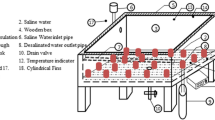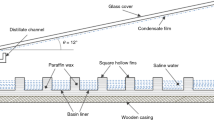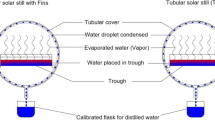Abstract
A detailed exergy analysis of a conventional and copper finned acrylic solar still has been presented in this manuscript. The evaporative, convective, and radiative heat transfer coefficient of water-glass has been calculated. Also energy efficiency, exergy destruction of basin, water, and glass has been determined. Conventional acrylic solar still with fins produced maximum hourly output of 1.24 kg and it produced daily output of 5.08 kg. The conventional acrylic solar still without fins produced maximum hourly output of 0.94 kg and it produced daily output of 3.75 kg. The maximum exergy destruction of the basin, water, and glass for the conventional acrylic solar still with fins are 655.206, 83.35, and 90.48 W/m2, respectively, and conventional acrylic solar still without fins are 616.28, 122.34, and 48.64 W/m2, respectively. The energy and exergy effectiveness of the conventional acrylic solar still with fins are 32 and 2.81%, respectively, and without fins are 24.93 and 1.69%, respectively. The study reveals that exergy destruction of water in the case of still with fins is minimum as related to the exergy destruction of water in the case of still without fins.











Similar content being viewed by others
Data availability
All data are given in the manuscript.
References
Abdelgaied M, Zakaria Y, Kabeel AE, Essa FA (2021) Improving the tubular solar still performance using square and circular hollow fins with phase change materials. J Energy Storage 38:102564
Abdullah AS, Omara ZM, Essa FA, Younes MM, Shanmugan S, Abdelgaied M, Amro MI, Kabeel AE, Farouk WM (2021a) Improving the performance of trays solar still using wick corrugated absorber, nano-enhanced phase change material and photovoltaics-powered heaters. J Energy Storage 40:102782
Abdullah AS, Omara ZM, Alarjani A, Essa FA (2021b) Experimental investigation of a new design of drum solar still with reflectors under different conditions. Case Stud Therm Eng 24:100850
Alaian WM, Elnegiry EA, Hamed AM (2016) Experimental investigation on the performance of solar still augmented with pin-finned wick. Desalination 379:10–15
Appadurai M, Velmurugan V (2015) Performance analysis of fin type solar still integrated with fin type mini solar pond. Sustain Energy Technol Assess 9:30–36
Arani RP, Sathyamurthy R, Chamkha A et al. (2021) Effect of fins and silicon dioxide nanoparticle black paint on the absorber plate for augmenting yield from tubular solar still. Environ Sci Pollut Res 28:35102–35112. https://doi.org/10.1007/s11356-021-13126-y
Bataineh KM, Abbas MA (2020) Performance analysis of solar still integrated with internal reflectors and fins. Sol Energy 205:22–36
Elashmawy M, Ahmed MM (2021) Enhancing tubular solar still productivity using composite aluminum/copper/sand sensible energy storage tubes. Sol Energy Mater Sol Cells 221:110882
Essa FA, Omara ZM, Abdullah AS, Kabeel AE, Abdelaziz GB (2021a) Enhancing the solar still performance via rotating wick belt and quantum dots nanofluid. Case Stud Therm Eng 27:101222
Essa FA, Omara Z, Abdullah A et al. (2021b) Augmenting the productivity of stepped distiller by corrugated and curved liners, CuO/paraffin wax, wick, and vapor suctioning. Environ Sci Pollut Res. https://doi.org/10.1007/s11356-021-14669-w
Essa FA, Alawee WH, Mohammed SA, Abdullah AS, Omara ZM (2021c) Enhancement of pyramid solar distiller performance using reflectors, cooling cycle, and dangled cords of wicks. Desalination 506:115019
Essa FA, Abdullah AS, Omara ZM, Kabeel AE, Gamiel Y (2021d) Experimental study on the performance of trays solar still with cracks and reflectors. Appl Therm Eng 188:116652
Jani HK, Modi KV (2019) Experimental performance evaluation of single basin dual slope solar still with circular and square cross-sectional hollow fins. Sol Energy 179:186–194
Kabeel AE, El-Maghlany WM, Abdelgaied M, Abdel-Aziz MM (2020) Performance enhancement of pyramid-shaped solar stills using hollow circular fins and phase change materials. J Energy Storage 31:101610
Manokar AM (2020) Experimental study on effect of different mass flow rate in an inclined solar panel absorber solar still integrated with spiral tube water heater. Desalin Water Treat 176:285–291. https://doi.org/10.5004/dwt.2020.25531
Manokar AM, Winston DP (2017) Comparative study of finned acrylic solar still and galvanised iron solar still. Mater Today: Proc 4(8):8323–8327
Manokar AM, Murugavel KK, Esakkimuthu G (2014) Different parameters affecting the rate of evaporation and condensation on passive solar still–A review. Renew Sust Energ Rev 38:309–322
Manokar AM, Winston DP, Kabeel AE, El-Agouz SA, Sathyamurthy R, Arunkumar T, Ahsan A (2018a) Integrated PV/T solar still-A mini-review. Desalination 435:259–267
Manokar AM, Winston DP, Kabeel AE, Sathyamurthy R (2018b) Sustainable fresh water and power production by integrating PV panel in inclined solar still. J Clean Prod 172:2711–2719
Manokar AM, Vimala M, Winston DP, Sathyamurthy R, Kabeel AE (2019) Effect of insulation on energy and exergy effectiveness of a solar photovoltaic panel incorporated inclined solar still—an experimental investigation. In Solar desalination technology (pp. 275–292). Springer, Singapore
Mevada D, Panchal H, kumar Sadasivuni K, Israr M, Suresh M, Dharaskar S, Thakkar H (2020) Effect of fin configuration parameters on performance of solar still: A review. Groundw Sustain Dev 10:100289
Mohaisen HS, Esfahani JA, Ayani MB (2021) Improvement in the performance and cost of passive solar stills using a finned-wall/built-in condenser: An experimental study. Renew Energy 168:170–180
Muthu Manokar A, Prince Winston D, Kabeel AE, Sathyamurthy R, Arunkumar T (2018) Different parameter and technique affecting the rate of evaporation on active solar still-a review. Heat Mass Transf 54:593–630
Omara ZM, Abdullah AS, Essa FA, Younes MM (2021) Performance evaluation of a vertical rotating wick solar still. Process Saf Environ Prot 148:796–804
Panchal H, Mevada D, Sadasivuni KK, Essa FA, Shanmugan S, Khalid M (2020) Experimental and water quality analysis of solar stills with vertical and inclined fins. Groundw Sustain Dev 11:100410
Rabhi K, Nciri R, Nasri F, Ali C, Bacha HB (2017) Experimental performance analysis of a modified single-basin single-slope solar still with pin fins absorber and condenser. Desalination 416:86–93
Sathyamurthy R, Mageshbabu D, Madhu B, Manokar AM, Prasad AR, & Sudhakar M (2020) Influence of fins on the absorber plate of tubular solar still-An experimental study. Materials Today: Proceedings. https://doi.org/10.1016/j.matpr.2020.11.355
Shmroukh AN, Ookawara S (2020) Evaluation of transparent acrylic stepped solar still equipped with internal and external reflectors and copper fins. Therm Sci Eng Prog 18:100518
Sivakumar V, Ganapathy Sundaram E (2017) Assessment of convective heat transfer coefficient and mass of water evaporated from a single-slope passive solar still by different thermal models: an experimental validation. Int J Ambient Energy 38(7):742–751
Sivakumar V, Ganapathy Sundaram E (2018) MATLAB modelling and examination of the effect of heat capacity of basin and glass cover on performance of solar still by thermal models. Int J Ambient Energy 39(1):1–10
Thalib M, Vimala M, Manokar AM et al. (2021) Energy, exergy and economic investigation of passive and active inclined solar still: experimental study. J Therm Anal Calorim 145:1091–1102. https://doi.org/10.1007/s10973-020-10501-8
Tuly SS, Rahman MS, Sarker MRI, Beg RA (2021) Combined influence of fin, phase change material, wick, and external condenser on the thermal performance of a double slope solar still. J Clean Prod 287:125458
Vaithilingam S, Esakkimuthu GS (2015) Energy and exergy analysis of single slope passive solar still: an experimental investigation. Desalin Water Treat 55(6):1433–1444
Younes MM, Abdullah AS, Essa FA, Omara ZM, Amro MI (2021) Enhancing the wick solar still performance using half barrel and corrugated absorbers. Process Saf Environ Prot 150:440–452
Yousef MS, Hassan H, Kodama S, Sekiguchi H (2019) An experimental study on the performance of single slope solar still integrated with a PCM-based pin-finned heat sink. Energy Procedia 156:100–104
Author information
Authors and Affiliations
Contributions
Sivakumar Vaithilingam—writing original manuscript & software
Vimala Muthu—writing original manuscript
Athikesavan Muthu Manokar—project administration, review & editing
Asif Afzal—review & editing
Ravishankar Sathyamurthy—formal analysis, review & editing
Corresponding author
Ethics declarations
Ethics approval and consent to participate
Not applicable
Consent for publication
Not applicable
Conflict of interest
The authors declare no competing interests.
Additional information
Responsible Editor: Philippe Garrigues
Publisher’s note
Springer Nature remains neutral with regard to jurisdictional claims in published maps and institutional affiliations.
Rights and permissions
About this article
Cite this article
Vaithilingam, S., Muthu, V., Athikesavan, M.M. et al. Energy and exergy analysis of conventional acrylic solar still with and without copper fins. Environ Sci Pollut Res 29, 6194–6204 (2022). https://doi.org/10.1007/s11356-021-16124-2
Received:
Accepted:
Published:
Issue Date:
DOI: https://doi.org/10.1007/s11356-021-16124-2




